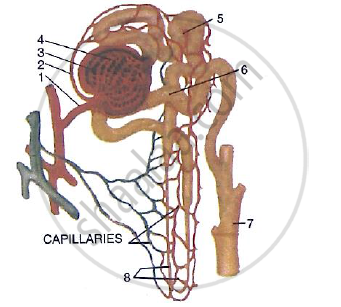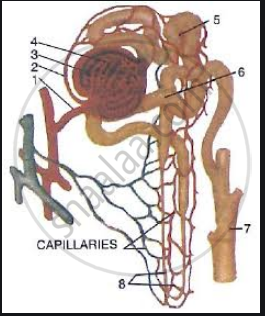Advertisements
Advertisements
प्रश्न
Answer the following in detail.
Describe the process of urine formation.
उत्तर
The process of urine formation takes place in the following steps:
- Glomerular Alteration: Blood containing waste material enters the kidneys through the renal artery. It then enters the glomerulus under high pressure. Water and small solutes are filtered in the Bowman’s capsule.
- Tubular reabsorption: Filterate passes through the thin walls of the Bowman’s capsule into the urinary or renal tubule. As it passes through the tubule, water, and many useful substances are reabsorbed by the renal blood capillaries.
- Tubular secretion: The remaining liquid, along with wastes such as urea, uric acid, etc., is called urine and is collected in the urinary bladder.
- Excretion: Urine leaves the kidneys and passes into the urinary bladder through the ureters. When the urinary bladder is full, urine is passed out through the urethra.
APPEARS IN
संबंधित प्रश्न
Where is the dirty blood in our body filtered?
What does the bladder in our body do?
The excretory organs in an earthworm are:
(a) nephridia
(b) nephrons
(c) raphides
(d) ureters
Answer the following in short.
Define transpiration in plants.
Differentiate between the following pairs of term :
Renal pelvis and renal papilla
The following diagram represents a mammalian kidney tubule (nephron) and its blood supply.

Parts indicated by the guidelines 1 to 8 are as follows:
1. Afferent arteriole from renal artery
2. efferent arteriole
3. Bowman’s capsule
4. Glomerulus;
5. Proximal convoluted tubule with blood capillaries;
6. Distal convoluted tubule with blood capillaries;
7. collecting tubule;
8. U-shaped loop of Henle
Study the diagram and answer the question that follow:
Where does ultrafiltration take place?
The following diagram represents a mammalian kidney tubule (nephron) and its blood supply.

Parts indicated by the guidelines 1to 8 are as follows:
1. Afferent arteriole from renal artery
2. Efferent arteriole
3. Bowman's capsule
4. Glomerulus
5. Proximal convoluted tubule with blood capillaries
6. Distal convoluted tubule with blood capillaries
7. Collecting tubule
8. U-shaped loop of Henle
Study the diagram and answer the question that follow:
Which structure (normally) contains the lowest concentration of glucose?
Among the following animals, the best conserver of water is ______.
Give two examples of the following:
Main excretory organs
The statement given below is false. Rewrite the correct form of the statement by changing the underlined word.
The pigment urochrome is the breakdown product of the haemoglobin of dead RBCs.
